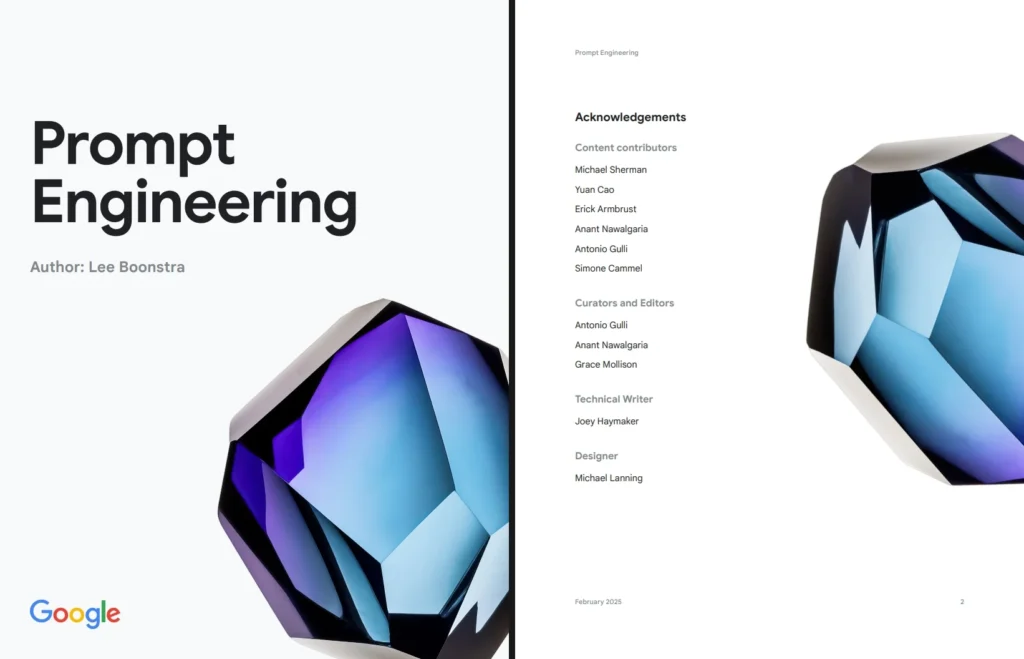Google’s Prompt Engineering Guide – Free Download
Stop wasting hours on prompts that don’t work. Every minute you spend struggling with poor AI outputs is time you could be using these tools to actually accelerate your productivity and creativity. The prompt engineering Lee Boonstra ebook offers a structured path from prompt confusion to AI mastery, with practical techniques that work across different models and use cases. Your frustration with inconsistent AI results ends here, replaced by confidence in your ability to engineer prompts that deliver professional-quality outputs consistently.
Download Prompt Engineering Ebook
What Makes Google’s Prompt Engineering Ebooks Stand Out?
Google’s approach to prompt engineering ebooks, including resources inspired by experts like Lee Boonstra, focuses on practical, research-backed methodologies rather than theoretical concepts. Here’s what you need to know:
- Structured frameworks – Google emphasizes systematic approaches over random trial-and-error prompting
- Model-agnostic techniques – Strategies that work across different AI platforms and models
- Practical applications – Real-world use cases for business, creative, and technical scenarios
- Iterative improvement – Methods for refining prompts based on output quality and consistency
- Scalable processes – Techniques that work for individual users and enterprise-level implementations
These resources typically combine technical depth with actionable guidance, making complex AI interaction principles accessible to both beginners and advanced users.
Download this ebook: https://drive.google.com/file/d/16jKXaL1OqpXjiPOWOu0_dCyqa84m0IeX/view?usp=sharing

Understanding Prompt Engineering Fundamentals
Prompt engineering represents the critical bridge between human intent and AI capability. When you understand how to structure your requests effectively, you transform from someone who occasionally gets lucky with AI outputs to someone who consistently engineers the results you need.
The foundation of effective prompt engineering rests on clear communication principles. Just as you wouldn’t give vague instructions to a colleague and expect perfect results, AI models require specific, well-structured guidance to perform optimally. This isn’t about memorizing magic words or secret formulas—it’s about understanding how these models process information and structuring your requests accordingly.
Context setting forms the backbone of professional prompt engineering. When you provide relevant background information, specify your desired output format, and clearly define success criteria, you’re essentially creating a blueprint for the AI to follow. This approach dramatically reduces the need for multiple iterations and helps you achieve your goals more efficiently.
Core Components of Effective Prompts
Every high-performing prompt contains several essential elements that work together to guide AI models toward your desired outcome. Role definition helps establish the perspective and expertise level you want the AI to adopt. Instead of generic responses, you get outputs tailored to specific professional contexts or creative requirements.
Task specification goes beyond simply stating what you want—it involves breaking down complex requests into clear, actionable components. When you specify not just the desired outcome but also the process, constraints, and quality standards, you’re providing the AI with a complete framework for success.
The format specification element often gets overlooked but plays a crucial role in usability. Whether you need bullet points, detailed explanations, code snippets, or creative content, explicitly stating your format preferences saves time and ensures the output matches your workflow requirements.
Examples and constraints provide additional guidance that helps AI models understand the boundaries and expectations for their responses. These elements act as guardrails, preventing outputs that might be technically correct but practically useless for your specific needs.
Advanced Prompt Engineering Strategies
Moving beyond basic prompting requires understanding sophisticated techniques that professional AI practitioners use to achieve consistent, high-quality results. Chain-of-thought prompting represents one of the most powerful approaches for complex problem-solving scenarios.
This technique involves explicitly asking the AI to show its reasoning process, breaking down complex tasks into logical steps. When you request step-by-step thinking, you not only get better final answers but also gain insights into the AI’s problem-solving approach, which helps you refine future prompts.
Few-shot learning within prompts leverages the AI’s ability to recognize patterns from examples. By providing 2-3 high-quality examples of your desired output, you essentially train the model on your specific requirements within the conversation context. This approach works particularly well for creative tasks, formatting requirements, and specialized domain applications.
Iterative Prompt Refinement
Professional prompt engineering involves systematic refinement based on output analysis. Version control for prompts becomes essential when you’re developing sophisticated AI workflows. Tracking which variations produce better results helps you build a library of effective prompt patterns for different use cases.
A/B testing your prompts might sound overly technical, but it’s simply about comparing different approaches to see which generates better results. This systematic approach prevents you from settling for “good enough” outputs when minor adjustments could yield significantly better results.
The feedback loop integration process involves analyzing AI outputs not just for accuracy but for consistency, creativity, and alignment with your goals. This analysis informs your next iteration, creating a continuous improvement cycle that enhances your prompting effectiveness over time.
Domain-Specific Prompt Engineering Applications
Different professional contexts require tailored prompt engineering approaches. Content creation prompts need to balance creativity with brand voice consistency, audience targeting, and SEO considerations. The most effective content prompts specify not just the topic but also the emotional tone, target audience knowledge level, and desired action outcomes.
Technical documentation prompts require precision and clarity above all else. When prompting for code documentation, API guides, or technical explanations, your prompts should emphasize accuracy, completeness, and accessibility for the intended technical audience.
Business analysis prompts benefit from structured analytical frameworks. Requesting specific methodologies like SWOT analysis, competitive comparison matrices, or financial projections helps ensure comprehensive, professionally formatted outputs that you can use directly in business contexts.
Creative and Marketing Applications
Creative writing prompts unlock AI’s storytelling capabilities when structured properly. Effective creative prompts establish genre conventions, character development requirements, and narrative structure preferences. They also specify the balance between originality and familiar elements that resonate with target audiences.
Marketing copy prompts require deep understanding of persuasion principles and brand voice consistency. The most successful marketing prompts incorporate customer pain points, value propositions, and call-to-action specifications while maintaining authentic brand personality throughout the generated content.
Social media prompts need to account for platform-specific requirements, character limits, hashtag strategies, and engagement optimization. Effective social media prompts also consider timing, audience behavior patterns, and viral content characteristics.
Technical Implementation and Best Practices
Prompt templates streamline your workflow by creating reusable structures for common tasks. Developing a library of tested templates for different scenarios saves time and ensures consistency across projects. These templates should include variable placeholders for customization while maintaining proven structural elements.
Parameter optimization involves understanding how different AI model settings affect output quality and consistency. Temperature settings, token limits, and other technical parameters can significantly impact results, and your prompts should account for these variables.
Integration strategies become crucial when incorporating AI into existing workflows. Your prompts should consider downstream processes, required output formats, and quality control checkpoints that ensure AI-generated content meets your standards before implementation.
Quality Control and Validation
Output validation frameworks help you systematically evaluate AI responses against your requirements. This involves creating checklists for accuracy, completeness, tone, and format compliance that ensure consistent quality across all AI-generated content.
Bias detection and mitigation requires conscious effort in prompt design. Effective prompts include instructions for balanced perspectives, diverse viewpoints, and fact-checking requirements that help minimize potential biases in AI outputs.
Scalability considerations become important when deploying prompt engineering techniques across teams or large-scale projects. Your prompts should be clear enough for others to use effectively while maintaining quality standards across different users and contexts.
Common Pitfalls and Solutions
Over-specification represents one of the most frequent mistakes in prompt engineering. While detail is important, excessively long prompts with unnecessary constraints can confuse AI models and reduce output quality. The key lies in finding the balance between sufficient guidance and creative freedom.
Under-specification creates the opposite problem, resulting in generic, unfocused outputs that require significant additional work. Effective prompts provide enough context and constraints to guide the AI toward useful results without being overly restrictive.
Inconsistent terminology within prompts can confuse AI models and lead to inconsistent outputs. Maintaining consistent vocabulary, especially for key concepts and requirements, helps ensure coherent, professional results across multiple interactions.
Performance Optimization
Prompt length optimization involves finding the sweet spot between comprehensive guidance and model processing efficiency. Different AI models handle various prompt lengths differently, and understanding these limitations helps you structure requests for optimal performance.
Response formatting considerations ensure that AI outputs integrate seamlessly into your existing workflows. Specifying formatting requirements upfront prevents the need for extensive post-processing and helps maintain consistency across projects.
Token efficiency becomes important for cost management and processing speed. Learning to communicate requirements effectively within token constraints helps you achieve better results while managing operational expenses.
Advanced Integration Techniques
API integration strategies allow you to incorporate prompt engineering techniques into automated workflows and applications. Understanding how to structure prompts for programmatic use opens up possibilities for scaling AI assistance across various business processes.
Multi-model approaches involve using different AI models for different aspects of complex tasks. Effective prompt engineering in this context requires understanding each model’s strengths and structuring requests to leverage these capabilities optimally.
Workflow automation combines prompt engineering with process automation tools to create sophisticated AI-powered systems. This approach requires careful consideration of handoffs between automated and human review stages.
Enterprise-Level Considerations
Team collaboration on prompt engineering requires documentation standards, version control systems, and knowledge sharing practices. Establishing these processes ensures that effective prompt patterns can be shared and improved across team members.
Compliance and governance frameworks become essential when deploying AI tools in regulated industries or sensitive contexts. Your prompt engineering practices should include guidelines for data handling, output review, and audit trail maintenance.
Performance monitoring helps you track the effectiveness of your prompt engineering strategies over time. Regular analysis of output quality, user satisfaction, and efficiency metrics informs continuous improvement efforts.
Measuring and Improving Results
Success metrics for prompt engineering go beyond simple output quality to include efficiency gains, consistency improvements, and user satisfaction scores. Establishing clear measurement criteria helps you evaluate the impact of your prompt engineering efforts objectively.
Continuous improvement processes involve regular review and refinement of your prompt libraries, templates, and techniques. This systematic approach ensures that your prompt engineering capabilities evolve with both technology advances and changing business requirements.
Knowledge management systems help capture and share effective prompt engineering techniques across teams and projects. Building institutional knowledge around successful prompt patterns accelerates learning and maintains consistency as teams grow.
The prompt engineering Lee Boonstra ebook and similar resources provide valuable frameworks for mastering these techniques, but success ultimately comes from consistent practice, systematic refinement, and deep understanding of both AI capabilities and your specific use case requirements. By implementing these strategies methodically and measuring results consistently, you’ll develop the expertise needed to unlock AI’s full potential for your professional and creative projects.
Source: https://www.kaggle.com/whitepaper-prompt-engineering










